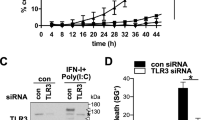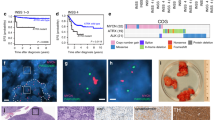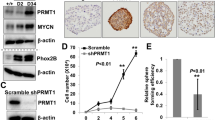Abstract
Neuroblastoma is a highly heterogeneous tumor of young children. Although many advances have been made towards understanding the molecular mechanisms dictating the phenotypic heterogeneity, the prognosis of children with neuroblastoma, particularly of progressively growing variants, has remained dire. About 10% of neuroblastomas regress spontaneously, probably by apoptosis, while another 20% have amplified the MYCN gene resulting in a poor prognosis. In pursuit of identifying cell death-associated genes in neuroblastoma, we encountered the SCA2 gene, coding for ataxin-2, as an important player. Here, we report that enforced expression of wild-type ataxin-2, but not of mutant ataxin-2, sensitizes neuroblastoma cells for apoptosis. In line with this, higher levels of ataxin-2 were detected in apoptotic cells compared to nonapoptotic cells. Neuroblastoma tumors with amplified MYCN contain significantly less ataxin-2 protein than tumors without amplified MYCN. Collectively, our data suggest that ataxin-2 has an important role in regulating the susceptibility of neuroblastoma cells to apoptotic stimuli in vitro and in vivo.
This is a preview of subscription content, access via your institution
Access options
Subscribe to this journal
Receive 50 print issues and online access
$259.00 per year
only $5.18 per issue
Buy this article
- Purchase on Springer Link
- Instant access to full article PDF
Prices may be subject to local taxes which are calculated during checkout






Similar content being viewed by others
References
Annicchiarico-Petruzzelli M, Bernassola F, Lovat PE, Redfern CP, Pearson AD and Melino G . (2001). Med. Pediatr. Oncol., 36, 115–117.
Bernassola F, Scheuerpflug C, Herr I, Krammer PH, Debatin KM and Melino G . (1999). Cell Death Differ., 6, 652–660.
Berthold F, Burdach S, Kremens B, Lampert F, Niethammer D, Riehm H, Ritter J, Treuner J, Utsch S and Zieschang J . (1990). Klin. Paediatr., 202, 262–269.
Berthold F and Hero B . (2000). Drugs, 59, 1261–1277.
Boehm U, Klamp T, Groot M and Howard JC (1997). Annu. Rev. Immunol., 15, 749–795.
Boon K, Caron HN, van Asperen R, Valentijn L, Hermus MC, van Sluis P, Roobeek L, Weis I, Voute PA, Schwab M and Versteeg R . (2001). EMBO J., 20, 1383–1393.
Catchpoole DR and Lock RB (2001). Eur. J. Cancer, 37, 2217–2221.
Cohen O, Feinstein E and Kimchi A . (1997). EMBO J., 16, 998–1008.
de Falco G and Giordano A . (1998). J. Cell Physiol., 177, 501–506.
Eggert A, Grotzer MA, Zuzak TJ, Wiewrodt BR, Ho R, Ikegaki N and Brodeur GM (2001). Cancer Res., 61, 1314–1319.
Estrada R, Galarraga J, Orozco G, Nodarse A and Auburger G . (1999). Acta. Neuropathol. (Berl.), 97, 306–310.
Foghsgaard L, Wissing D, Mauch D, Lademann U, Bastholm L, Boes M, Elling F, Leist M and Jaattela M . (2001). J. Cell Biol., 153, 999–1010.
Fulda S, Kufer MU, Meyer E, van Valen F, Dockhorn-Dworniczak B and Debatin KM (2001). Oncogene, 20, 5865–5877.
Fulda S, Lutz W, Schwab M and Debatin KM (1999). Oncogene, 18, 1479–1486.
Gil J and Esteban M . (2000). Oncogene, 19, 3665–3674.
Green DR . (2000). Cell., 102, 1–4.
Huynh DP, Figueroa K, Hoang N and Pulst SM . (2000). Nat. Genet., 26, 44–50.
Ikeda H, Hirato J, Akami M, Suzuki N, Takahashi A, Kuroiwa M and Matsuyama S . (1996). Am. J. Surg. Pathol., 20, 649–655.
Imbert G, Saudou F, Yvert G, Devys D, Trottier Y, Garnier JM, Weber C, Mandel JL, Cancel G, Abbas N, Durr A, Didierjean O, Stevanin G, Agid Y and Brice A . (1996). Nat. Genet., 14, 285–291.
Johnstone RW, Ruefli AA and Lowe SW . (2002). Cell, 108, 153–164.
Leone G, Sears R, Huang E, Rempel R, Nuckolls F, Park CH, Giangrande P, Wu L, Saavedra HI, Field SJ, Thompson MA, Yang H, Fujiwara Y, Greenberg ME, Orkin S, Smith C and Nevins JR . (2001). Mol. Cell, 8, 105–113.
Lutz W, Fulda S, Jeremias I, Debatin KM and Schwab M . (1998). Oncogene, 17, 339–346.
Lutz W, Stohr M, Schurmann J, Wenzel A, Lohr A and Schwab M . (1996). Oncogene, 13, 803–812.
Mac SM, D'Cunha CA and Farnham PJ . (2000). Mol. Carcinogen., 29, 76–86.
Muller H, Bracken AP, Vernell R, Moroni MC, Christians F, Grassilli E, Prosperini E, Vigo E, Oliner JD and Helin K . (2001). Genes Dev., 15, 267–285.
Nakagawara A, Nakamura Y, Ikeda H, Hiwasa T, Kuida K, Su MS, Zhao H, Cnaan A and Sakiyama S . (1997). Cancer Res., 57, 4578–4584.
Nechiporuk T, Huynh DP, Figueroa K, Sahba S, Nechiporuk A and Pulst SM . (1998). Hum. Mol. Genet., 7, 1301–1309.
Pritchard J and Hickman JA . (1994). Lancet, 344, 869–870.
Pulst SM, Nechiporuk A, Nechiporuk T, Gispert S, Chen XN, Lopes-Cendes I, Pearlman S, Starkman S, Orozco-Diaz G, Lunkes A, DeJong P, Rouleau GA, Auburger G, Korenberg JR, Figueroa C and Sahba S . (1996). Nat. Genet., 14, 269–276.
Sanpei K, Takano H, Igarashi S, Sato T, Oyake M, Sasaki H, Wakisaka A, Tashiro K, Ishida Y, Ikeuchi T, Koide R, Saito M, Sato A, Tanaka T, Hanyu S, Takiyama Y, Nishizawa M, Shimizu N, Nomura Y, Segawa M, Iwabuchi K, Eguchi I, Tanaka H, Takahashi H and Tsuji S . (1996). Nat. Genet., 14, 277–284.
Savelyeva L and Schwab M . (2001). Cancer Lett., 167, 115–123.
Stark GR, Kerr IM, Williams BR, Silverman RH and Schreiber RD . (1998). Annu. Rev. Biochem., 67, 227–264.
Teitz T, Lahti JM and Kidd VJ . (2001). J. Mol. Med., 79, 428–436.
Teitz T, Wei T, Valentine MB, Vanin EF, Grenet J, Valentine VA, Behm FG, Look AT, Lahti JM and Kidd VJ . (2000). Nat. Med., 6, 529–535.
van Golen CM, Castle VP and Feldman EL (2000). Cell Death Differ., 7, 654–665.
van Golen CM, Schwab TS, Ignatoski KM, Ethier SP and Feldman EL . (2001). Cell Growth Differ., 12, 371–378.
Varfolomeev EE, Schuchmann M, Luria V, Chiannilkulchai N, Beckmann JS, Mett IL, Rebrikov D, Brodianski VM, Kemper OC, Kollet O, Lapidot T, Soffer D, Sobe T, Avraham KB, Goncharov T, Holtmann H, Lonai P and Wallach D . (1998). Immunity, 9, 267–276.
Wittke I, Wiedemeyer R, Pillmann A, Savelyeva L, Westermann F and Schwab M . (2002). Submitted.
Acknowledgements
F Westermann and I Wittke contributed equally to this work. The authors thank Dr D Rudnicki and Prof. G Auburger for pCI-SCA2-CAG22, Prof. PH Krammer for the C15 antibody and the members of the German Neuroblastoma Study Group. This work was supported by Deutsche Krebshilfe, Deutsche Forschungsgemeinschaft, BMBF, Deutsches Humangenomprojekt and the Cooperation Program in Cancer Research of the Deutsches Krebsforschungszentrum (DKFZ) and Israel's Ministry of Science (MOS).
Author information
Authors and Affiliations
Corresponding author
Rights and permissions
About this article
Cite this article
Wiedemeyer, R., Westermann, F., Wittke, I. et al. Ataxin-2 promotes apoptosis of human neuroblastoma cells. Oncogene 22, 401–411 (2003). https://doi.org/10.1038/sj.onc.1206150
Received:
Revised:
Accepted:
Published:
Issue Date:
DOI: https://doi.org/10.1038/sj.onc.1206150
Keywords
This article is cited by
-
Genetic ablation of ataxin-2 increases several global translation factors in their transcript abundance but decreases translation rate
neurogenetics (2015)
-
Ataxin-2 Modulates the Levels of Grb2 and Src but Not Ras Signaling
Journal of Molecular Neuroscience (2013)
-
Epigenetics DNA methylation in the core ataxin-2 gene promoter: novel physiological and pathological implications
Human Genetics (2012)
-
The role of deubiquitinating enzymes in apoptosis
Cellular and Molecular Life Sciences (2011)
-
Neurotoxic protein oligomerisation associated with polyglutamine diseases
Acta Neuropathologica (2010)



